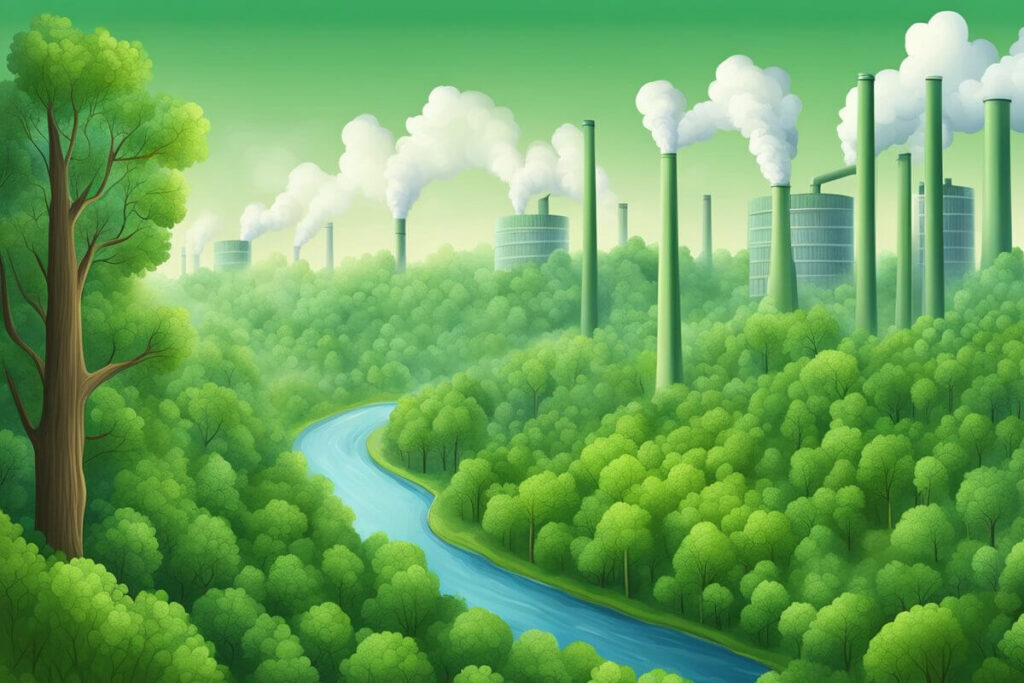What Does Carbon Negative Mean?
When a company or country is “carbon negative,” it goes beyond achieving carbon neutrality. Instead of simply balancing out greenhouse gas emissions, being carbon negative means actively removing more carbon dioxide from the atmosphere than is emitted. This ambitious approach is increasingly seen as a necessary step in combating climate change. By investing in green technologies and innovative practices, entities can draw down excess atmospheric CO2, helping to reverse some of the damage done by decades of fossil fuel use.

The concept of carbon negativity intertwines with large-scale efforts to address climate change. It takes a deliberate and proactive stance, targeting the root of the issue by effectively reducing the overall concentration of greenhouse gases. Organizations and governments play pivotal roles in implementing the strategies that can make carbon negative solutions a reality. The path to becoming carbon negative is lined with challenges, including economic, technological, and policy hurdles, but the long-term benefits for the planet could be profound.
Key Takeaways
- Carbon negative actions aim to remove more CO2 from the atmosphere than is emitted.
- Strategies for carbon negativity are critical in combating climate change.
- Overcoming barriers to these strategies requires innovation and policy support.
Understanding Carbon Negative
Carbon negative actions refer to processes that actually removes more carbon dioxide (CO2) from the atmosphere than the person or group releases. To be carbon negative, an entity must not only reduce emissions but also create an environmental benefit by removing additional CO2. Generally, this can involve a variety of strategies, like purchasing carbon offsets, planting trees, or employing carbon capture and storage technologies.
Carbon Negative vs. Carbon Neutral
While both concepts aim at mitigating climate change, there’s a fundamental difference:
- Carbon Neutral: Achieving a state where the total emissions produced are balanced by the amount of emissions removed. Think of it as breaking even with your carbon footprint.
- Carbon Negative: Going a step beyond to create a net decrease in atmospheric CO2 levels. You’re not just balancing; you’re tipping the scales in favor of the planet by becoming a carbon cleaner-upper, so to speak.
The Importance of Reducing Emissions
Reducing greenhouse gas emissions is crucial in your fight against climate change. Achieving carbon negative status is essential in this battle, as it effectively reverses some of the damage done by these gases. While reaching net-zero emissions is a significant milestone, pushing past that to become carbon negative—sometimes referred to as climate positive—can help heal ecosystems and slow global warming. Transitioning to carbon negative technologies and practices presents an aggressive, yet increasingly necessary approach to address the climate crisis.
Approaches to Carbon Negativity
Achieving carbon negativity involves a multi-faceted approach, blending high-tech innovations with natural processes to remove more carbon from the atmosphere than is emitted.

Carbon Capturing Technologies
Carbon capture and sequestration/storage (CCS)[1] is your high-tech beacon of hope. It’s where industrial emissions are trapped at the source and then tucked away underground or converted into useful byproducts. For example, direct air carbon capture bumps up the ante by snatching CO2 directly from the air we breathe. This tech isn’t just for the big players; smaller setups are also coming into play, turning carbon dioxide into something more benign, or even profitable.
Nature-Based Solutions
Here’s where Mother Nature gets a say. Nature-based solutions bank on the power of plants and the earth to pull carbon from the air. You’ve got reforestation, which is as straightforward as it sounds – more trees, more carbon storage. Then there’s the slick use of biochar, charcoal derived from plant matter, which improves soil health while clutching carbon tight for centuries.
The Role of Governments and Organizations
In the fight against climate change, your government and favorite companies are taking steps that may affect your world. They’re key players in shaping a carbon-negative future through policies, corporate actions, and global commitments.

Policy Making and International Agreements
Governments wield a hefty toolset to combat emissions: regulation and agreements. For instance, Joe Biden’s administration has rejoined the Paris Agreement, signaling the United State’s commitment to reducing global warming. This international deal is a rally cry for countries like China and France to set ambitious climate goals.
Corporate Commitment to Carbon Negativity
Over on the corporate side, big companies like Microsoft are stepping up their game. They’ve pledged to become carbon negative, meaning they aim to remove more carbon from the atmosphere than they emit. It’s not just a feel-good statement; they’re investing in carbon offsets and changing business practices to reach this goal.
Global Initiatives and Pledges
Countries are also banding together with global initiatives to keep the planet cool. New Zealand is one of the stars, showing the world how a smaller nation can set big targets to cut emissions – setting their goal to reach net-zero emissions by the year 2050. These pledges, supported by both state and federal governments, not only aim to slow down global warming but also inspire others to follow suit. It’s like an environmentally-focused chain reaction, where one good deed sparks another, creating a cascade of positive change.
Challenges and Considerations
When aiming to reach carbon-negative status, you’re bound to run into some hurdles. These challenges span from economic to social spheres, and understanding them is crucial.

Economic and Technological Barriers
Your pursuit of carbon-negative solutions will likely first hit financial and tech roadblocks. The cost of technology required for carbon capture can be steep. For instance, retrofitting a coal-fired power plant with these technologies necessitates significant investment. Moreover, current carbon removal technologies often come at a high price, pushing the carbon budget to its limits. Ensuring these technologies are both affordable and scalable is a tough nut to crack but essential for widespread emission reduction.
Social and Political Factors
Now, let’s talk about the people side of things. Farmers, for example, will need to navigate the transition towards these improved practices while balancing profitability and fairness.
Additionally, policies supporting carbon-negative ventures must align with public interest to garner widespread support. The political will to impose regulations on emissions, incentivize greener tech, and tackle vested interests in fossil fuels is often a tricky affair.
The Future of Carbon Negativity
In the race to curb climate change, achieving carbon negativity is like hitting a home run. You’re not just stopping new greenhouse gas emissions; you’re actively wiping out some of the old ones too.

Advancements in Carbon Reduction
Renewable Energy: One big player in slashing emissions is renewable energy. Solar panels and wind energy are stars here, converting sun and air into power without the guilt-trip of fossil fuels. It’s like tapping into nature’s endless battery, and the tech is getting better every year.
Energy Sector Innovation: Think of this as the energy sector going on an efficiency diet. Companies are working toward zero emissions, getting leaner by the day. Some are even aiming to be net-zero emitters, meaning they’ll only cough up as much carbon as they can offset.
Promoting Sustainable Livelihoods and Ecosystems
Agriculture’s Makeover: Your food’s journey to your plate is getting greener. Agriculture is cutting back on carbon footprint with practices like rotational grazing and precision farming. These aren’t just good for the environment; they’re great for farmers’ wallets too.
Biodiversity for the Win: Protecting ecosystems isn’t just about saving the cute animals; it’s about keeping Earth’s carbon cycle in shape. Healthy forests and wetlands are pro at sucking out carbon dioxide, so investing in them is like hiring a top-notch cleanup crew.
Remember, you’re part of the solution: every energy-saving choice you make, like picking renewable energy sources or supporting sustainable farming, pushes us closer to a carbon-negative future.
Frequently Asked Questions
How can a country achieve a carbon negative status?
A country can achieve carbon negative status primarily through methods that absorb carbon such as reforestation or using carbon capture and storage technologies. Additionally, transitioning to renewable energy sources plays a vital role in reducing overall carbon emissions.
Is being carbon negative truly beneficial?
Yes, carbon negative actions can be truly beneficial as they aim to remove excess carbon dioxide from the atmosphere — the main driver of climate change. This goes beyond merely stopping new emissions and works towards reversing past environmental impacts.
What is the difference between carbon neutral and carbon negative?
Being carbon neutral means that any CO2 released is balanced by an equivalent amount sequestered or offset, while carbon negative means more CO2 is taken out of the atmosphere than is emitted, creating a net reduction.
What types of products are considered carbon negative?
Products like biochar or certain building materials can be considered carbon negative when their production captures more carbon than it releases. Additionally, products from companies that invest in carbon-negative processes contribute to the category.
How does carbon negative compare to just hitting net zero?
While hitting net zero means balancing emissions with removals, carbon negative takes it further — you’re actually tipping the scales to remove additional CO2 from the atmosphere, positively impacting global carbon levels.
Natural Replacements references research from industry experts and reputable industry publishers to support claims or data in our content when applicable. Learn more about our publishing standards and practices in our editorial guidelines.
- Resources for the Future (RFF) - Carbon Capture and Storage 101
Accessed: February 19, 2024
X
Citations for This Article
APA
Replacements, Natural Replacements Staff. (June 30, 2024). What Does Carbon Negative Mean?. Natural Replacements. Retrieved November 30, 2025, from https://naturalreplacements.com/learn/environment/carbon-negative/
MLA
Replacements, Natural Replacements Staff. "What Does Carbon Negative Mean?." Natural Replacements, https://naturalreplacements.com/learn/environment/carbon-negative/
Chicago
Replacements, Natural Replacements Staff. "What Does Carbon Negative Mean?." Natural Replacements, Last modified June 30, 2024. https://naturalreplacements.com/learn/environment/carbon-negative/
